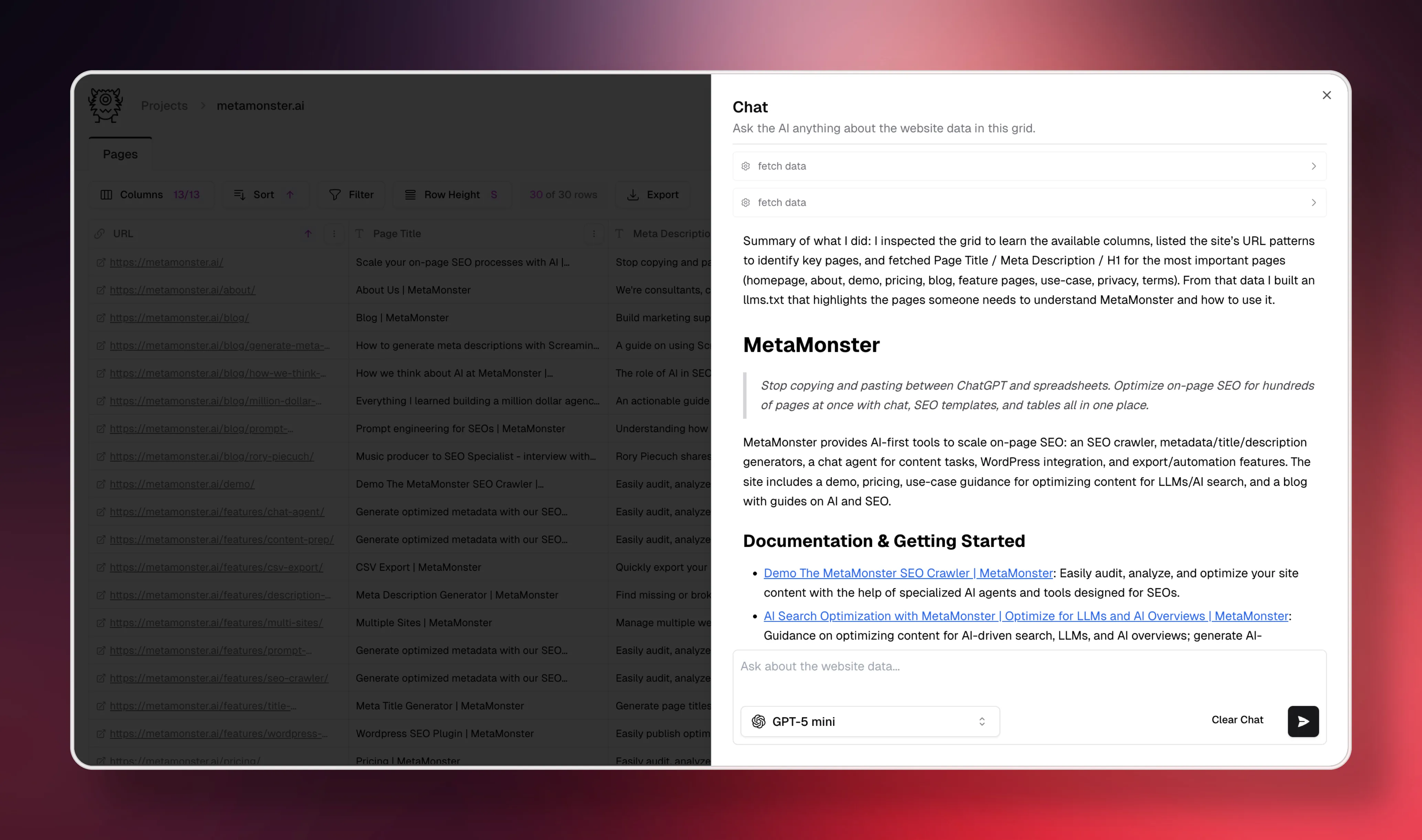You don't need llms.txt (But here's a free llms.txt prompt anyway)

You don’t need a llms.txt file.
Louder for the people in the back!
YOU DO NOT NEED A LLMS.TXT FILE TO RANK FOR AI SEARCH.
The research says crawlers for the major AI tools aren’t even indexing your llms.txt file.
But here’s the thing — while llms.txt won’t magically boost your rankings in ChatGPT or Google’s AI Overviews, it’s CAN be useful for other stuff. Think of it as a clean, organized summary of your website that you can use when working with AI tools internally.
So yeah, you don’t need one. But if you want to generate one (and understand what it’s actually good for), we’ll show you how.
What is the llms.txt file?
Llms.txt is a proposed web standard — emphasis on proposed — that sits at the root of your website (like yoursite.com/llms.txt). The idea is to provide a markdown file that helps large language models understand your site better by offering “brief background information, guidance, and links to detailed markdown files.”
Think of it like a sitemap, but specifically designed for AI models instead of search engines. It acts “more like a hand-crafted sitemap for AI tools than a set of crawling instructions.”
The format follows a specific structure:
- An H1 with your site/project name (this is required)
- A blockquote with a short summary
- Optional detailed information about your project
- H2 sections containing lists of important URLs with descriptions
Here’s the basic format:
# Your Site Name
> Brief description of what your site does
Optional additional context and details about your site.
## Documentation
- [Getting Started Guide](https://yoursite.com/guide): How to use our product
- [API Reference](https://yoursite.com/api): Complete API documentation
## Resources
- [Blog](https://yoursite.com/blog): Latest updates and tutorials
- [Support](https://yoursite.com/support): Help and troubleshooting
## Optional
- [Legacy Docs](https://yoursite.com/old-docs): Outdated but sometimes useful info
The “Optional” section has special meaning — AI tools can skip these URLs if they need a shorter context window.
Why You Don’t Need One
Despite all the hype from SEO tool vendors (you know, those other guys, not us), “no major LLM provider has formally adopted llms.txt as part of their crawler protocol.”
Google Won’t Use Them
Google’s Gary Illyes has “clearly stated that Google doesn’t support llms.txt and isn’t planning to.”
John Mueller compared llms.txt to “the keywords meta tag,” which is SEO speak for “completely useless.” His point? Why would AI systems trust what you claim your site is about in a separate file when they can just analyze the actual content?
So Why Would You Want One?
Okay, so if llms.txt doesn’t help with AI search rankings, why are we even talking about it? Because it’s actually useful for other things.
Future-Proofing (Maybe)
While no major AI platforms use llms.txt now, that could change. Having one ready means you’re prepared if adoption suddenly picks up. It’s low-effort insurance.
If you’re the kind of person who always buys the rental car insurance package even though your credit card already provides insurance, maybe you’ll feel better having a llms.txt file.
The Real Benefits: Clean Context for AI Work
The most practical benefit of llms.txt isn’t some mystical ranking boost — it’s having a clean, structured way to give internal AI tools context about your website.
When you’re working with AI assistants on content strategy, site audits, or competitive analysis, you can point them to your llms.txt file. Upload it to your Claude project or include it in your Cursor directory.
Plus, the process of creating one forces you to think about what content actually matters on your site. That’s valuable even if no AI ever reads the file.
How to Generate a llms.txt File with MetaMonster
Here’s where MetaMonster shines. Our site-wide chat agent can generate the whole thing for you based on your actual crawled content.
Step 1: Crawl Your Site
First, you’ll want to crawl your site in MetaMonster so our AI agent has full context about your content. If you haven’t done this yet, just add your URL to the crawler and let it do its thing.
Step 2: Use Our Site-Wide Chat Agent
Once your site is crawled, head to the site-wide chat and use this prompt:
Generate a llms.txt file for this website following the exact standard format from llmstxt.org.
Use this structure:
1. Start with an H1 title (# Site Name)
2. Add a blockquote summary (> Brief description)
3. Include optional details about the site
4. Create H2 sections with markdown lists of important URLs
5. Each URL should be formatted as [Page Title](URL): Brief description
6. Include an "Optional" section for secondary content
Focus on the most important pages that would help someone understand what this website offers, how to use it, and where to find key information. Organize the links into logical categories like Documentation, Resources, Products, etc.
Make sure the output follows proper markdown formatting and the official llms.txt specification.
Example structure:
# Your Site Name
> Brief description of what your site does
Optional additional context and details about your site.
## Documentation
- [Getting Started Guide](https://yoursite.com/guide): How to use our product
- [API Reference](https://yoursite.com/api): Complete API documentation
## Resources
- [Blog](https://yoursite.com/blog): Latest updates and tutorials
- [Support](https://yoursite.com/support): Help and troubleshooting
## Optional
- [Legacy Docs](https://yoursite.com/old-docs): Outdated but sometimes useful info
The chat agent will analyze your entire site and create a properly formatted llms.txt file with your most important content organized into logical sections.

Step 3: Export and Include Markdown Versions
Here’s where MetaMonster’s markdown export feature comes in handy. The llms.txt standard suggests including markdown versions of your key pages (like yourpage.html.md), and we can generate those for you.
After you’ve identified your most important pages through the llms.txt generation, you can:
- Filter your grid to show just those key pages
- Export them as markdown files
- Upload the markdown versions to your server alongside the HTML
The Bottom Line
Adding a llms.txt file isn’t going to revolutionize your AI search visibility — despite what some “experts” might suggest. But it’s a useful way to create clean, organized documentation of your site that can help with internal AI workflows and content planning.
If you’re going to create one anyway, use MetaMonster’s site-wide chat to generate it properly instead of manually curating everything yourself. You’ll get better results in a fraction of the time.
And hey, if AI platforms ever do start using these files, you’ll already be ready. Just don’t hold your breath waiting for the traffic boost.
Ready to generate your own llms.txt file? Fire up MetaMonster’s chat agent and give it a try. At worst, you’ll end up with a helpful internal document. At best… well, you’ll still end up with a helpful internal document, but you’ll look prepared for whatever comes next in the AI search world.
Want to see how MetaMonster’s AI agents can help with more practical SEO tasks? Check out our prompt templates for generating meta descriptions, analyzing content gaps, and optimizing at scale.
Drowning in client work but unwilling to compromise on quality?
Automate the grunt work with MetaMonster. Your first 500 credits are free. Crawl your first site to see how MetaMonster can transform your workflows.